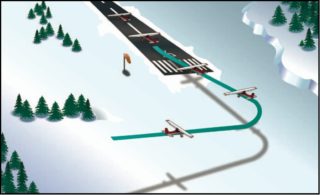Few turns in aviation are as dangerous as the “base-to-final” turn. That’s the last turn the pilot executes to line up with the runway. 
When that final turn is made, the aircraft is always low and slow. If the pilot tightens the turn too much, the aircraft can stall and crash. The factors that contribute to a base-to-final crash include:
- The pilot carrying too much speed, thus requiring a tighter turn so as not to overshoot the runway centerline;
- A tail wind requiring a tighter turn so as not to overshoot the runway centerline;
- The aircraft being low in the turn, leading the pilot to compensate by pulling the nose up;
- High density altitude conditions which result in an indicated airspeed yielding a higher groundspeed than normal;
- High density altitude conditions which results in decreased aircraft performance.
It’s of course too early to tell why the Challenger N605TR crashed at Truckee. But the accident has all the earmarks of a base-to-final stall/spin. All of the above-listed contributing factors may have been at play, making the base-to-final turn especially hazardous for the crew. And witnesses report seeing the aircraft in an extreme left wing down attitude shortly before impact – just as is typical in these sorts of accidents..
All too frequently, smaller general aviation aircraft fall victim to the base-to-final stall/spin . But large jet aircraft like the Challenger typically avoid the risk by lining up with the runway centerline while still miles away from the airport. Because large jets cannot fly slow, and because jet engines respond to throttle inputs relatively slowly, jets such as the Bombardier Challenger are ill-suited for tight maneuvering flight low to the ground near landing speeds.
Seems as though in attempting to maneuver to the runway, these pilots had the deck stacked against them.
The animation below syncs ATC communications with the aircraft’s flight path.
Challenger 605 crashes during approach at Truckee/Tahoe, CA – YouTube




